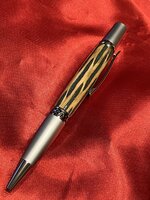Kenny Durrant
Member
Thanks to KMCloonan for giving me the idea to give this a try. A friend gave me a bunch of different crushed stones and I thought this would be a great way to start playing with it. I started by drilling the cactus and gluing in the tube. That way the pattern is uniform all the way around the pen. Then I turned the cactus close to the bushings to save the powder and have less room for voids. I must say that was quite a mess. So after that I turned it to size and shape and gave it another several coats of CA to smooth out the rough spots. The sanded it smooth and started my regular CA finishing. Questions and Comments are Welcome. Thanks


